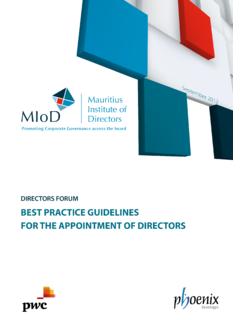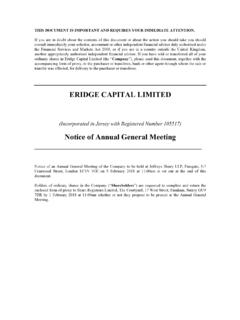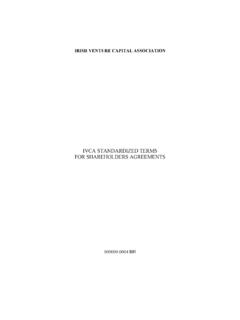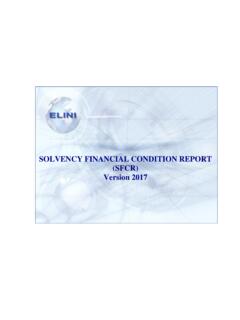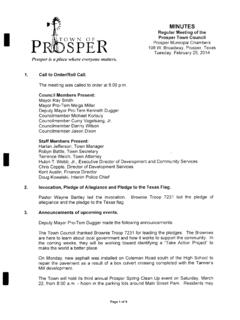Transcription of Presidential Appointments to Full-Time Positions in ...
1 CRS Report for CongressPrepared for Members and Committees of Congress Presidential Appointments to Full-Time Positions in independent and Other Agencies During the 110th Congress Maeve P. Carey Analyst in Government Organization and Management Henry B. Hogue Analyst in American National Government April 20, 2011 Congressional Research Service7-5700 R41776 Presidential Appointments to independent Agencies During the 110th Congress Congressional Research Service Summary The appointment process for advice and consent Positions consists of three main stages. The first stage is selection, clearance, and nomination by the President. This step includes preliminary vetting, background checks, and ethics checks of potential nominees. At this stage, the President may also consult with Senators who are from the same party if the position is located in a state. The second stage of the process is consideration of the nomination in the Senate, most of which takes place in committee.
2 Finally, if a nomination is approved by the full Senate, the nominee is given a commission signed by the President and sworn into office. During the 110th Congress, President George W. Bush submitted to the Senate 52 nominations to independent and other agencies for Full-Time Positions . Of these 52 nominations, 27 were confirmed, 9 were withdrawn, and 16 were returned to him in accordance with Senate rules. For those nominations that were confirmed, an average of 110 days elapsed between nomination and confirmation. The President made two recess Appointments to Full-Time Positions in independent agencies during the 110th Congress. Each recess appointment was followed by a nomination which is included in the total of 52 nominations. The methodology used in this report to count the length of time between nomination and confirmation differs from that which was used in previous similar CRS reports.
3 The statistics presented here include the days during which the Senate was adjourned for its summer recesses and between sessions of Congress. The methodological change, which may reduce the comparability of statistics in this report with those of the earlier research, is discussed in the text of this report, as well as in Appendix E. Reasons for the change include the Senate s conversion of traditionally long recesses into a series of short recesses punctuated by pro forma sessions during the 110th Congress; the fact that although committees may not be taking direct action on nominations in the form of hearings or votes, they are likely still considering and processing nominations during recesses; and a desire to be consistent with the methodology used by many political scientists as well as CRS research on judicial nominations. In addition, an argument could be made that the decision to extend Senate consideration of nominees over the course of a recess is intentional, and the choice to extend this length of time is better represented by including all days, including long recesses.
4 Information for this report was compiled from data from the Senate nominations database of the Legislative Information System at , the Congressional Record (daily edition), the Weekly Compilation of Presidential Documents, telephone discussions with agency officials, agency websites, the United States Code, and the 2008 Plum Book (United States Government Policy and Supporting Positions ). This report will not be updated. Presidential Appointments to independent Agencies During the 110th Congress Congressional Research Service Contents Introduction .. 1 The Appointments Process .. 1 Selection, Clearance, and Nomination .. 1 Senate 3 appointment .. 4 Recess Appointments ..4 Temporary Appointments .. 6 Appointments During the 110th Congress .. 6 Average time to Confirm a Nomination .. 7 Organization of This Report .. 8 Agency Profiles .. 8 Additional appointment 9 Nominations and Incumbents: Full-Time Positions in independent Agencies.
5 10 Appalachian Regional Commission (ARC) .. 10 Broadcasting Board of Governors (BBG) .. 10 Central Intelligence Agency (CIA) .. 10 Corporation for National and Community Service (CNCS).. 11 Court Services and Offender Supervision Agency to the District of Columbia (CSOSA) ..12 Delta Regional Authority (DRA) .. 12 Environmental Protection Agency (EPA).. 12 Federal Mediation and Conciliation Service (FMCS).. 14 General Services Administration (GSA) .. 14 Millennium Challenge Corporation (MCC) .. 14 National Aeronautics and Space Administration (NASA).. 15 National Archives and Records Administration (NARA) .. 15 National Foundation on the Arts and Humanities (NFAH) .. 16 National Science Foundation (NSF) .. 16 Office of the Director of National Intelligence (ODNI).. 17 Office of Government Ethics (OGE) .. 17 Office of Navajo and Hopi Indian Relocation (ONHIR).. 18 Office of Personnel Management (OPM).
6 18 Office of Special Counsel (OSC).. 19 Overseas Private Investment Corporation (OPIC).. 19 Peace Corps (PC)..19 Selective Service System (SSS).. 20 Small Business Administration (SBA) .. 20 Social Security Administration (SSA).. 21 Trade and Development Agency (TDA) .. 22 Agency for International Development (USAID) .. 22 Nominations and Incumbents: Full-Time Positions in the Executive Office of the President .. 24 Council of Economic Advisers (CEA).. 24 Council on Environmental Quality (CEQ) .. 24 Office of Management and Budget (OMB).. 25 Office of National Drug Control Policy (ONDCP).. 25 Presidential Appointments to independent Agencies During the 110th Congress Congressional Research Service Office of Science and Technology Policy (OSTP).. 26 Office of the Trade Representative (OUSTR).. 26 Nominations and Incumbents: Full-Time Positions in Multilateral 28 African Development Bank (AfDB).
7 28 Asian Development Bank (AsDB).. 28 European Bank for Reconstruction and Development (EBRD) .. 29 Inter-American Development Bank (IADB) .. 29 International Bank for Reconstruction and Development (World Bank) (IBRD).. 30 International Joint Commission, and Canada (IJC).. 30 International Monetary Fund (IMF).. 31 Nominations and Incumbents: Full-Time Positions in Legislative Branch Agencies .. 32 Architect of the Capitol (AOC) .. 32 Government Accountability Office (GAO) .. 32 Government Printing Office (GPO) .. 33 Library of Congress (LOC) .. 33 Appendixes Appendix A. Summary of All Nominations and Appointments to independent and Other Agencies .. 34 Appendix B. Nomination Action by Agency Type, 110th Congress .. 36 Appendix C. Agency 37 Appendix D. Senate Intersession Recesses and Intrasession Recesses of Four or More Days, 110th 39 Appendix E. Change in Methodology from Previous Tracking 40 Contacts Author Contact Information.
8 41 42 Presidential Appointments to independent Agencies During the 110th Congress Congressional Research Service 1 Introduction This report explains the process for filling Positions to which the President makes Appointments with the advice and consent of the Senate (PAS Positions ).1 It also identifies, for the 110th Congress, all nominations to Full-Time Positions requiring Senate confirmation in 39 organizations in the executive branch (26 independent agencies, 6 agencies in the Executive Office of the President (EOP), and 7 multilateral banking organizations) and 4 agencies in the legislative branch. It excludes Appointments to executive departments and to regulatory and other boards and commissions, which are covered in other reports. A profile of each agency tracks the agency s nominations, providing information on Senate activity (confirmations, rejections, returns to the President, and elapsed time between nomination and confirmation) as well as further related Presidential activity (including withdrawals and recess Appointments ).
9 The profiles also identify, for each agency, Positions requiring Senate confirmation, the incumbents in those Positions as of the end of the 110th Congress, and the pay levels of those officials. The Appointments Process The Constitution (Article II, Section 2) empowers the President to nominate and, by and with the advice and consent of the Senate, to appoint the principal officers of the United States, as well as some subordinate Officers of the United States are those individuals serving in high-ranking Positions that have been established by Congress and exercising significant authority pursuant to the laws of the United States (emphasis added).3 Three distinct stages mark the appointment process: selection and nomination, confirmation, and appointment . Selection, Clearance, and Nomination In the first stage, the White House selects and clears a prospective appointee before sending a formal nomination to the Senate.
10 There are a number of steps in this stage of the process for most Senate-confirmed Positions . First, with the assistance of, and preliminary vetting by, the White House Office of Presidential Personnel, the President selects a candidate for the position. Members of Congress and interest groups sometimes recommend candidates for specific PAS Positions . They may offer their suggestions by letter, for example, or by contact with a White 1 The acronym is defined as Presidential appointment with Senate Confirmation in the 2004 Plum Book ( Congress, Senate Committee on Homeland Security and Governmental Affairs, United States Government Policy and Supporting Positions , 110th Cong., 2nd sess., committee print, Nov. 12, 2008 (Washington: GPO, 2008)). 2 A historical and contemporary overview of the appointment power is found in Louis Fisher, appointment Powers, in his Constitutional Conflicts between Congress and the President, 4th ed.

